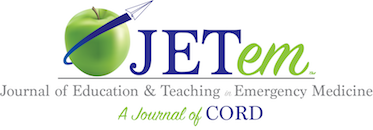Code Social: Integrating SDoH into Emergency Resident Education
ABSTRACT:
Audience:
This small group curriculum is geared toward medical students and residents of all levels of training in emergency medicine programs.
Introduction:
Emergency departments serve as critical first points of contact for patients with acute health needs, often exacerbated by social determinants of health (SDoH). Incorporating SDoH awareness into emergency medicine practice is essential for addressing immediate health concerns, preventing future crises, and reducing the burden on healthcare systems. By identifying and addressing social factors, emergency providers can break cycles of recurrent emergencies, connect patients with community resources, and foster trust-based, patient-centered relationships. Training emergency medicine residents in SDoH is crucial for preparing them to provide comprehensive, equitable care to diverse populations, enhancing their ability to advocate for vulnerable groups and reduce health disparities. This simulation curriculum aims to immerse residents in scenarios that highlight SDoH impacts, equipping them with the skills to recognize, address, and provide resources for patients affected by social determinants, ultimately improving overall patient outcomes and quality of care in emergency settings.
Educational Objectives:
The educational objectives of this activity are to: 1) enhance residents’ understanding and recognition of (SDoH) in emergency medicine; 2) develop residents’ skills in addressing SDoH within the emergency medicine setting; 3) foster a patient-centered approach that promotes health equity in emergency medicine; and 4) identify local resources available to address various SDOH.
Educational Methods:
The curriculum employs a comprehensive, multi-faceted approach to educate emergency medicine residents about SDoH. It combines didactic lectures, online simulations, clinical case scenarios, debriefing sessions, and community engagement activities to provide a well-rounded learning experience.
Research Methods:
Pre- and post-curriculum surveys were employed to evaluate the effectiveness of the SDoH training program for residents. These surveys assessed residents’ confidence in understanding SDoH, their ability to recognize SDoH impacts on emergency department patients, and their knowledge of related community resources and support services, before and after the curriculum. The pre-survey established a baseline, while the post-survey measured the impact of the training. Additionally, verbal feedback from residents and faculty was collected to gather insights and suggestions for improvement. This comprehensive evaluation approach aimed to ensure the curriculum’s responsiveness to residents’ needs and facilitate ongoing refinement of the simulation program.
Results:
A comprehensive survey of 16 emergency medicine residents across various training levels achieved full participation, assessing their understanding of SDoH, recognition of SDoH impacts on patients, and knowledge of relevant community resources. Analysis of pre- and post-curriculum responses demonstrated that while residents had initial SDoH awareness, the curriculum significantly deepened their comprehension and practical application of SDoH concepts. Notably, residents showed substantial improvement in identifying SDoH effects on patients’ overall health and well-being, with the most significant progress in their familiarity with SDoH-related community resources. These results highlight the curriculum’s success in equipping emergency medicine residents to provide holistic, equitable care and champion health equity in their practice.
Discussion:
The innovative SDoH curriculum for emergency medicine residents shows promising results in enhancing comprehensive and equitable care delivery. Utilizing diverse educational methods including lectures, simulations, case studies, and community engagement, the program effectively translates theoretical SDoH knowledge into practical skills. Significant improvements in residents’ understanding, identification, and knowledge of local SDoH resources highlight the curriculum’s efficacy. These outcomes indicate that the program successfully prepares residents to navigate the complex relationship between social factors and health outcomes in emergency settings, potentially fostering more patient-centered care and advancing health equity. While these initial findings are encouraging, it’s important to recognize the study’s limitations and consider future research opportunities to further validate and refine the curriculum’s impact.
Topics:
Social medicine, social determinants of health, homelessness, health literacy, limited English proficiency.
